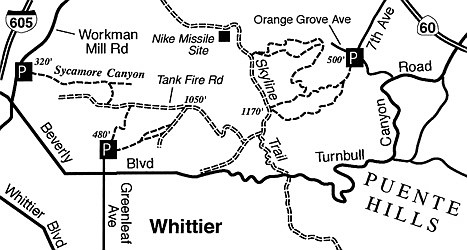 Facebook
Facebook
 X
X
 Instagram
Instagram
 TikTok
TikTok
 Youtube
Youtube
The name “Sycamore Canyon” in California geography plays a rather redundant role. How many canyons have specimens of native sycamore, and how many of those were named (either in English or in Spanish) after that tree? Surely dozens.
One such Sycamore Canyon lies in the rambling Puente Hills, which keep at bay the vast urban sprawl of the San Gabriel Valley to the north and Orange County to the south. A large part of the Puente Hills has been set aside for habitat preservation and public recreation. Just off the freeway, so to speak, you can discover Sycamore Canyon and spend an hour or so strolling down its length. The canyon harbors some fine riparian habitat overlooked by some rather dramatic, eroded cliffs. There are several large and twisted specimens of California sycamore trees to admire, as well as willows, cottonwoods, and toyons — the latter bearing clusters of bright, red berries in late fall and winter.
To get there, exit Interstate 605 at Beverly Boulevard in Whittier. Go east on Beverly for 0.6 mile and turn left (north) on Workman Mill Road. Go 0.4 mile north to the obscure gated entrance to Sycamore Canyon on the right. There is no parking lot, but you can park your vehicle alongside the curb.
From the curbside trailhead, bypass the vehicle gate and proceed east up the narrow trail, following signs. You’ll pass a groaning oil well (one of the relatively few still operating in the L.A. Basin), and bend left to join a wider path, which is an old roadbed that currently functions as the Sycamore Canyon Trail. Note the contrast between the sheer and barren south-facing canyon wall on the left, which bears the full force of sunlight, and the more gently sloping north-facing, grassy slopes on the right.
After 1.0 mile of travel, the main trail turns sharply right and wastes no time in ascending those grassy slopes. Straight ahead (east) lies a sketchy trail that continues up Sycamore Canyon toward a tributary ravine called Dark Canyon. This juncture is a good place to turn around and return if your hike is going to be a casual one. If you decide to hike farther into Sycamore Canyon, then watch out for poison oak.
This article contains information about a publicly owned recreation or wilderness area. Trails and pathways are not necessarily marked. Conditions can change rapidly. Hikers should be properly equipped and have safety and navigational skills. The Reader and Jerry Schad assume no responsibility for any adverse experience.
Sycamore Canyon/Puente Hills
Explore a sycamore-dotted crease in the pillowy Puente Hills near Whittier.
Distance from downtown San Diego: 112 miles
Biking length: 2 miles (round trip)
Difficulty: Easy


The name “Sycamore Canyon” in California geography plays a rather redundant role. How many canyons have specimens of native sycamore, and how many of those were named (either in English or in Spanish) after that tree? Surely dozens.
One such Sycamore Canyon lies in the rambling Puente Hills, which keep at bay the vast urban sprawl of the San Gabriel Valley to the north and Orange County to the south. A large part of the Puente Hills has been set aside for habitat preservation and public recreation. Just off the freeway, so to speak, you can discover Sycamore Canyon and spend an hour or so strolling down its length. The canyon harbors some fine riparian habitat overlooked by some rather dramatic, eroded cliffs. There are several large and twisted specimens of California sycamore trees to admire, as well as willows, cottonwoods, and toyons — the latter bearing clusters of bright, red berries in late fall and winter.
To get there, exit Interstate 605 at Beverly Boulevard in Whittier. Go east on Beverly for 0.6 mile and turn left (north) on Workman Mill Road. Go 0.4 mile north to the obscure gated entrance to Sycamore Canyon on the right. There is no parking lot, but you can park your vehicle alongside the curb.
From the curbside trailhead, bypass the vehicle gate and proceed east up the narrow trail, following signs. You’ll pass a groaning oil well (one of the relatively few still operating in the L.A. Basin), and bend left to join a wider path, which is an old roadbed that currently functions as the Sycamore Canyon Trail. Note the contrast between the sheer and barren south-facing canyon wall on the left, which bears the full force of sunlight, and the more gently sloping north-facing, grassy slopes on the right.
After 1.0 mile of travel, the main trail turns sharply right and wastes no time in ascending those grassy slopes. Straight ahead (east) lies a sketchy trail that continues up Sycamore Canyon toward a tributary ravine called Dark Canyon. This juncture is a good place to turn around and return if your hike is going to be a casual one. If you decide to hike farther into Sycamore Canyon, then watch out for poison oak.
This article contains information about a publicly owned recreation or wilderness area. Trails and pathways are not necessarily marked. Conditions can change rapidly. Hikers should be properly equipped and have safety and navigational skills. The Reader and Jerry Schad assume no responsibility for any adverse experience.
Sycamore Canyon/Puente Hills
Explore a sycamore-dotted crease in the pillowy Puente Hills near Whittier.
Distance from downtown San Diego: 112 miles
Biking length: 2 miles (round trip)
Difficulty: Easy
